Contents
Growing tomatoes in a greenhouse, the gardener must not only competently care for the plantings, but also regularly carefully examine them for symptoms of various ailments. So, you can observe the twisting of the leaves of a tomato in a greenhouse. Such a nuisance may be a symptom of a disease, the result of exposure to pests, or a violation of the rules for cultivating tomatoes. Below in the article we will talk about how to determine the specific cause of leaf curl and timely, quickly eliminate it.
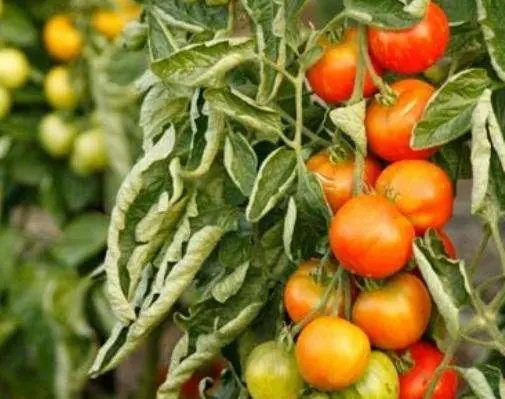
Twisted leaves – a universal symptom of improper care
Even an experienced specialist will definitely not be able to answer the question of why the leaves of a tomato curl in a greenhouse. After all, the reasons for the appearance of this symptom can be different, and for an accurate determination it is necessary to visually assess the condition of the tomato, in which direction the foliage is twisting, what additional changes are observed on the bush. A detailed description of some of the causes of crowded leaves is given below. In the same place, to establish the exact cause, possible accompanying symptoms of malaise and ways to eliminate the trouble are given.
Reason at the root
Damage to the roots can cause leaf curl in greenhouse tomatoes. Most often this happens in the process of planting tomato seedlings in the soil. When taking seedlings out of the container, it is very easy to damage the roots without even noticing it. However, the slightest injury to the root system can lead to the fact that for several days after planting, tomato leaves will be in a twisted state. After the injury has healed during the rooting process, the tomato leaves will even out and in a few days this anomaly will disappear.
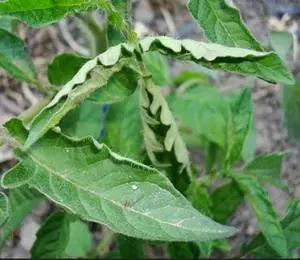
It is worth noting that tomatoes can also be damaged as a result of loosening the root system. And although the roots of this culture are located deep enough, it is impossible to loosen the soil deeper than 4-5 cm.
Violation of the rules of watering
Deeply located tomato roots need enhanced watering. After all, a small amount of water can only moisten the top layer of soil without nourishing the tomatoes themselves. That is why the lack of moisture is one of the most common reasons that the leaves of tomatoes in the greenhouse are twisted.

To eliminate this reason, you need to regularly water the tomatoes with plenty of water. For example, in a polycarbonate greenhouse, fruit-bearing bushes need to be watered once every 1-2 days, spending at least 3 liters of warm water on each plant. Such a volume of liquid must be poured gradually to the stem of the tomatoes so that the water nourishes the soil without spreading. Mulching loosened beds also helps retain moisture in the soil, preventing it from drying out.
It is worth noting that the cause of twisted leaves can be not only a lack, but also an excess of water in the soil. If the gardener does not follow the watering regime and regularly “floods” the tomatoes, then the roots of the plants will eventually begin to experience a lack of oxygen and will signal this with the edges of their leaves, bending them up. Thus, it is very important to monitor soil moisture, since its lack or excess can lead to plant wilt, root rot, and the development of fungal diseases.
High temperature in the greenhouse
Tomatoes are heat-loving plants, however, temperatures exceeding +350C can burn them. One of the signs of excessive heat in a greenhouse is curled leaves. This reason can be established exactly using a simple visual analysis: the leaves curl at high temperatures in the greenhouse during the day, and after sunset, the greenhouse conditions change, the temperature drops, the tomato leaves stop curling, straightening their plate completely by night.
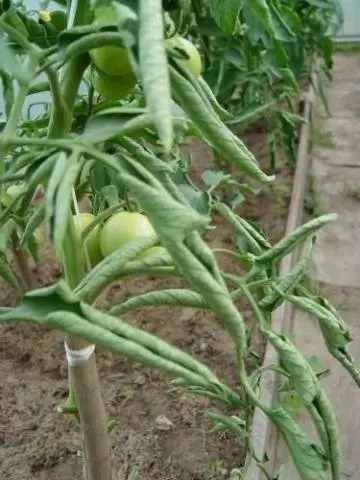
You can reduce the temperature in the greenhouse and restore the condition of the tomatoes with the help of ventilation. Spraying tomato leaves with urea also relieves heat stress in plants. For spraying on the sheet, prepare a solution of 1 tbsp. l. substances on a bucket of water. Urea treatment, which is also a nitrogen supplement, should be carried out exclusively in the evening or in cloudy weather.
Incorrect formation of the bush
Growing tomatoes in a greenhouse, the gardener seeks to form bushes as compactly as possible, removing extra stepchildren, the lower leaves of tomatoes. This measure allows you to improve air circulation in a confined space and thereby prevent the development of certain diseases, rotting of tomatoes. Removing excess vegetation also contributes to the early ripening of fruits, their better filling.
In an effort to get a tomato crop faster, some gardeners begin to form tomato bushes soon after planting, when the plant adaptation has not yet passed. After the removal of the vegetative organs, which perform the function of a conditional “pump” of nutrients, the root system cannot properly nourish the tomato bush. As a result of such an incorrect formation of bushes, the foliage of tomatoes in the greenhouse is bent. You can support the culture at this difficult moment by introducing nutrients with the help of foliar top dressing on the sheet.

Proper and timely formation of the bush avoids twisting of the leaves. So, the first operation to remove leaves and stepsons can be carried out no earlier than 3 weeks after planting the plants in the greenhouse. Then the formation is carried out every 2 weeks, removing no more than 3 sheets at a time.
The listed causes of leaf curl are easy to identify and eliminate: the leaves are curled, but there are no spots, stains with discoloration, holes or insects on them. When proper care is restored, tomatoes quickly “come to life”, straightening their leaves. Short-term twisting does not affect crop yield or overall plant health. At the same time, growing tomatoes in a greenhouse without eliminating the cause can lead to the death of the bushes.
You can see an example of twisted leaves in a greenhouse and get expert advice on eliminating the cause of the ailment in the video:
Cause of sickness
What to do if the leaves of tomatoes in the greenhouse are curled, but the care of the plants is carried out in full and in accordance with all the rules? In this case, the cause of the malaise should be sought in diseases and parasitism of pests. You can identify the problem by a number of accompanying signs, the description of which is given below.

Bacterial cancer
This bacterial disease often affects individual tomato bushes in greenhouse conditions. You can identify the disease by the following symptoms:
- tomato leaves curl down, quickly wither, turn brown and dry;
- cracks, ulcers and bumps appear in the lower part of the stem;
- yellow round spots appear on ripe and unripe tomatoes. In the context of the fetus, blackening can be observed.
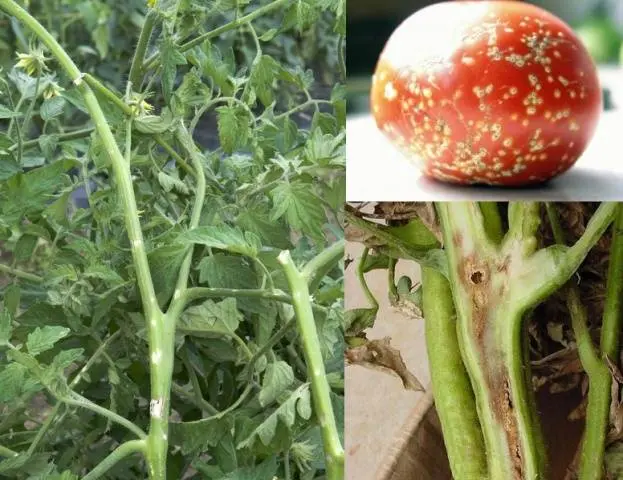
When a diseased bush is found in a greenhouse, care must be taken to destroy it. To do this, the bush is cut off at the root, treated with copper oxychloride and left to dry on the trellis. After drying, the bush and its root are taken out of the greenhouse and destroyed by burning. The tomatoes remaining in the greenhouse are also treated with a solution of copper oxychloride (40 g per 10 l of water) to prevent the spread of the disease.
Tobacco mosaic
Tomato disease is caused by viruses and can spread quickly in a greenhouse from one plant to another. When tomatoes are infected with tobacco mosaic, the leaves acquire a bumpy surface and curl. At the same time, a pattern is formed on the leaf plate with alternating spots and stains of various dark and light green shades.
You can see the symptoms and hear recommendations for the treatment of this disease in the video:

Fuzarioz
This fungal disease can also be found under the name Fusarium wilt. If the tomato leaves in the greenhouse gradually twisted into a tube, and the symptom spreads throughout the plant from the lower leaves to the crown, then this disease can be suspected. Associated symptoms in this case should be:
- leaves become light green in color;
- affected, twisted foliage falls off;
- upper leaves and shoots of tomato wither;
- a pink bloom forms at the bottom of the stem.

In addition to the above symptoms, at high humidity, infected plants may become covered with a light-colored bloom. You can fight the disease with the help of broad-spectrum antifungal drugs. If emergency measures to prevent a fungal disease are not taken, then all plants in the greenhouse may suffer. The fungus in the ground and on the walls of the building will successfully survive until next year and will also hit the plants in the future.
Verticillary wilting
An inexperienced gardener can confuse this disease with fusarium, since the symptoms of these ailments are very similar. With verticillium wilt, the leaves begin to curl up. The color of the foliage changes, becoming yellowish. As the disease develops, the leaves turn yellow more and more, and some of them even fall off, however, this does not prevent the tomato bush from surviving until the end of the season.

It is these diseases that most often become a prerequisite for the leaves of tomatoes in the greenhouse to spin and change their color, begin to turn yellow. It is imperative to fight against viral and fungal diseases, since the harmful microflora can remain in the greenhouse for a long period of time, damaging the next year’s plants. In order to prevent various diseases with the onset of the new season, it is necessary to treat the inner surface of the greenhouse with disinfectants.
Leaves curling as a result of insect attack
Various insects strive to feast on the juices of tomato leaves. As a result of such parasitism, the leaves begin to wither, turn yellow, curl and dry out. Leaf curl in greenhouse tomatoes can be caused by aphids, spider mites, or whiteflies. You can see these pests in the photo below.
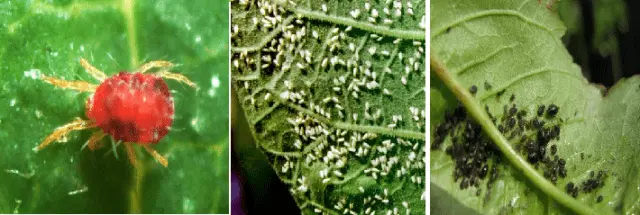
It is worth noting that a spider mite in the course of its life activity can tightly wrap a tomato leaf with its web, creating a home in the form of a tube. Black aphids, when sucking out nutrients, inject a special substance that poisons the plant and causes the leaves to curl and turn yellow.
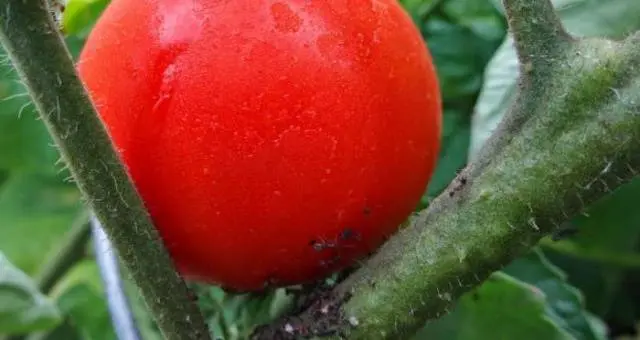
You can fight insects with the help of various chemicals or by attracting traps. Among the folk remedies for pest control, spraying plants with a decoction of chamomile or yarrow shows high efficiency. Tobacco infusion is also able to repel harmful insects.
Imbalance of nutrients in the soil
It is no secret that in order to grow tomatoes, it is necessary to regularly maintain a certain composition of the soil. The word “maintain” in this context is very appropriate, since even the most nutritious soil is depleted in the process of cultivating plants, which forces the farmer to fertilize. In the process of feeding, the gardener may incorrectly calculate the dosage of substances, thereby causing some problems. So, the lack and excess of some microelements can cause twisting of tomato leaves:
- signs of an excess amount of nitrogen are twisted leaves, excessive thickening of the stems and stepchildren of the plant (tomato fattening). At the same time, the gardener observes low flowering activity;
- Tomatoes report a lack of potassium by twisting the leaf. In this case, yellowing of the veins and a change in the color of the edges of the foliage can be observed, it becomes brown;
- lack of phosphorus can be identified by twisted leaves and red-purple leaf veins. The tissues of the leaf plate between the veins at the same time become grayish-green;
- with a lack of copper, tomato leaves at the top of the bush curl inward towards the midrib. In a neglected situation, yellow spots appear on the leaf plates.
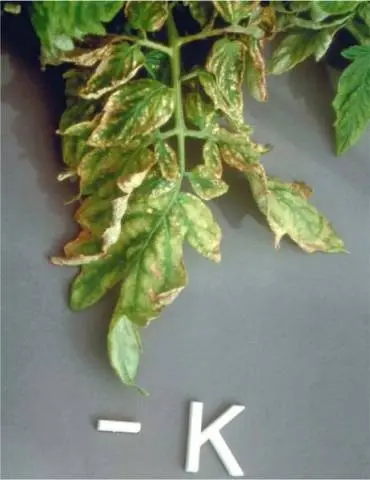
You can compensate for the lack of minerals by spraying the leaves of the plant with microelement solutions. In this case, the tomatoes will quickly absorb the necessary substances, their condition will soon improve. With an excess of mineral, you can use the method of washing out the soil, in which it is necessary to water the plants with large amounts of water.
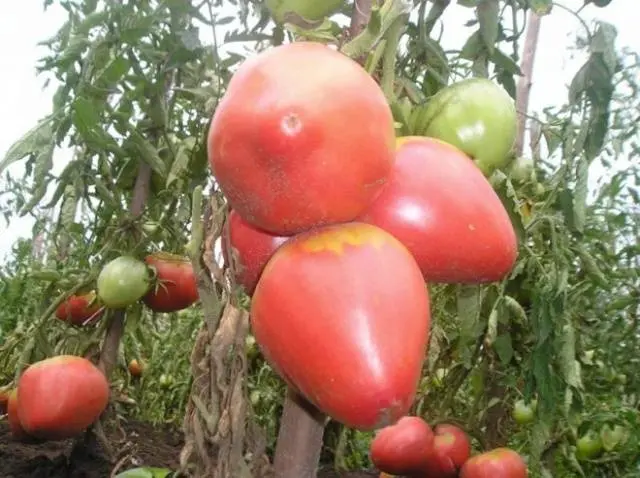
To summarize
If, after reading the article, it did not become clear why the leaves of tomatoes curl in greenhouse conditions, where all the rules for growing crops are observed and a favorable microclimate prevails, and there are no concomitant symptoms of diseases and parasitism of insects on the leaves, then it is worth considering, maybe twisting leaves is a varietal feature of a tomato? For example, many indeterminate tomatoes have thin, heavily indented leaves that curl slightly inwards. Some varieties of cherry tomatoes also have this feature, so if tomatoes of such varieties as Fatima (photo above), Honey Drop or Oxheart grow in the greenhouse, then you should not be upset when you see twisted leaves, since such a sign is the norm for a plant.









